Menu
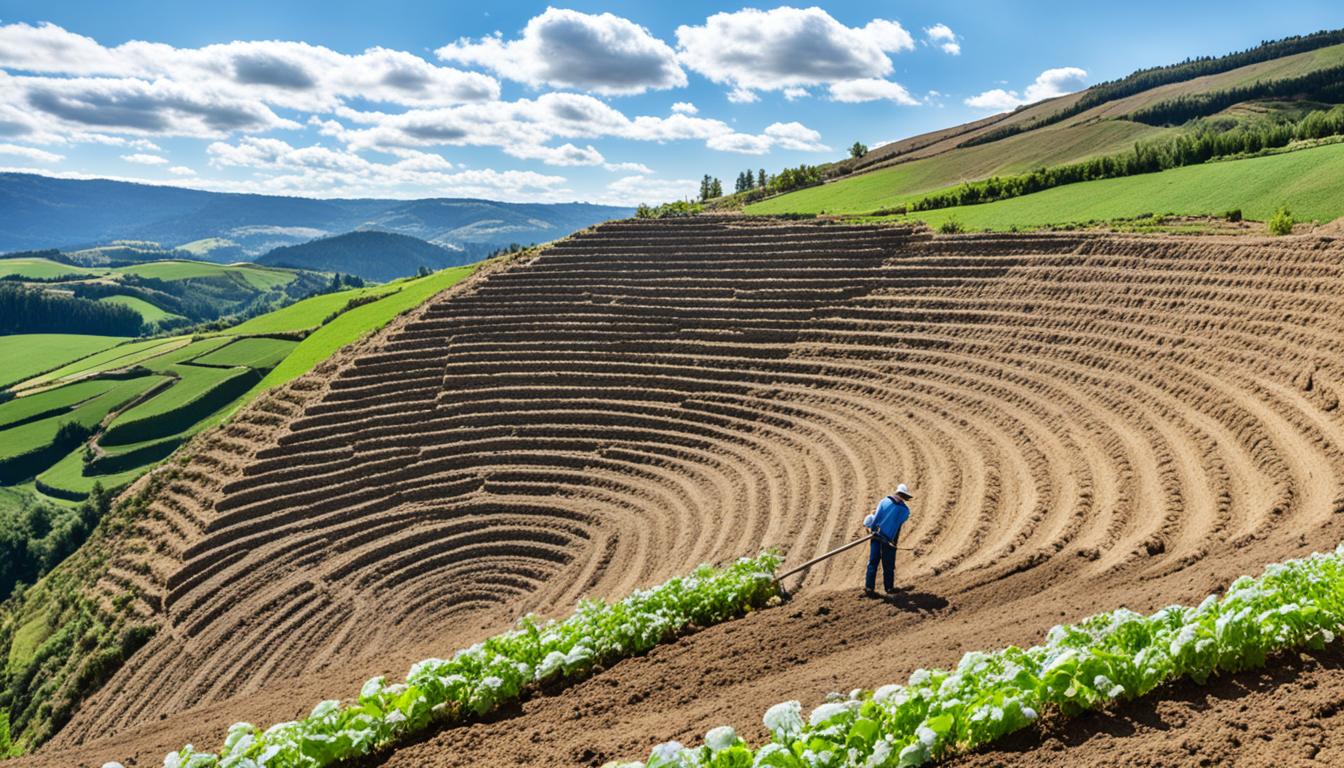
Contour farming can cut soil erosion on moderate slopes by 50%. This is a big deal. It shows how crucial good soil conservation methods are. They help keep our land fertile and our farms sustainable. Soil conservation involves farming in ways that stop land from getting worse. It keeps the soil full of different kinds of life. And ensures our farms will work well for years to come.
Using methods like less ploughing and contour farming really help manage our land. These ways are key for keeping the soil safe and helping farmers. Remote sensing tech makes it easier and cheaper to protect the soil for the future. Want to learn more about these methods? Visit the introduction of soil conservation measures.
Soil conservation is vital for keeping our land healthy and usable for the future. It aims to stop soil from getting worse through erosion, depletion, and pollution. Tools like remote sensing help farmers save soil more efficiently and cheaply.
Soil conservation means protecting the soil from damage like erosion and chemicals. Its main goal is to keep the soil healthy for a long time. This helps plants grow well and supports many living things.
Soil conservation is extremely important today. Climate change and overuse threaten our land constantly. Practices that protect the soil also help us by cleaning water and air, providing homes for animals, and increasing soil’s ability to grow food.
Acquiring knowledge of land resources: Understanding soil composition and properties for informed conservation decisions.
Monitoring fields for critical zones: Identifying areas at high risk of degradation and implementing targeted measures.
Assessing conservation technique effectiveness: Regular evaluation of applied practices to ensure optimal outcomes.
| Method | Benefits |
|---|---|
| Conservation Tillage | Can leave 20-30% of soil surface covered with crop residue |
| No-Till Farming | Can cover 60-70% of a field with crop residue |
| Crop Rotation | Reduces risk of insect and disease problems, decreases pesticide dependency |
| Windbreaks | Reduces wind erosion significantly for 15-20 times the height of the trees downwind |
Soil erosion is a huge issue for farms, causing a drop in productivity. It also upsets the balance of nature. That’s why stopping erosion is essential for saving the soil for tomorrow.
Soil erosion is the movement of topsoil by wind, water or human actions. This hurts the land by making it less fertile. Keeping an eye on soil health is key to fighting this problem.
Many things lead to soil erosion. Old ways of farming, like slash-and-burn, plus cutting down too many trees, and letting too many animals graze, make it worse.
Now, big machines in farming press soil down hard, making it harder to grow crops. Also, chemicals used in farming pollute the soil and water, making erosion more likely.
Stopping erosion takes many steps. Checking the fields and how well we conserve helps a lot. Some ways to control erosion are using less invasive farming methods.
For example, leaving crops on the soil after harvesting, or planting without digging much can really help. These methods keep soil healthy and stop it from blowing or washing away.
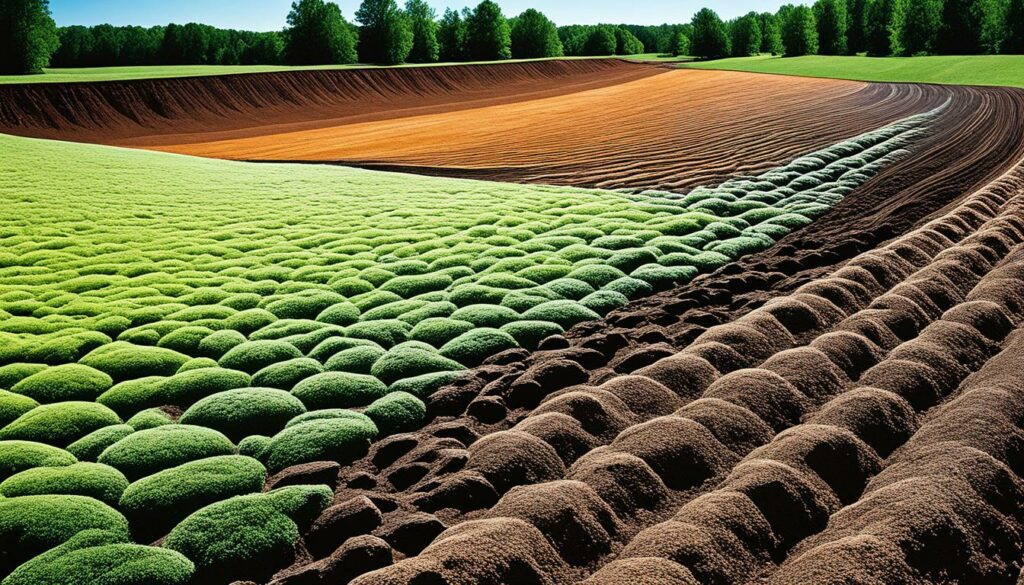
There are other good ways to prevent erosion too. Planting crops along the land’s natural lines helps slow water down. This can be really useful.
Also, having different crops next to each other can break the power of strong wind and water. Trees or bushes in rows, called windbreaks, can protect the soil from the wind.
Finally, using new technology to watch over the soil and farming can mean we use better, cheaper ways to save the land. Thanks to this smart farming, we can keep the earth safe for our kids and their kids.
Sustainable land management is key for sustainable farming. It uses methods that help the land and the economy. It focuses on keeping the soil healthy and the wildlife rich. This makes sure that farmlands will be productive for years to come.
Sustainable land management involves many practices like crop rotation and using cover crops. These methods avoid harming the land, unlike traditional farming. They also protect the soil and help the land produce more. So, they create stronger ecosystems.
Using these farming methods has many good points. They make the land produce better by keeping the soil healthy. No-till farming and contour farming help keep the ground stable and stop it from washing away. This also makes the water cleaner and supports wildlife.
| SLM Practice | Benefits |
|---|---|
| Crop Rotation | Improves soil structure and fertility, reduces pest and disease cycles |
| No-Till Farming | Prevents erosion, enhances soil moisture retention, maintains soil structure |
| Cover Crops | Suppresses weeds, enhances soil organic matter, improves biodiversity |
| Buffer Strips | Controls sediment run-off, filters pollutants, enhances water quality |
Soil conservation techniques are key to keeping farm lands healthy for the long term. By using different methods, we help improve soil health, watch over farm changes, and ensure soil is well looked after.
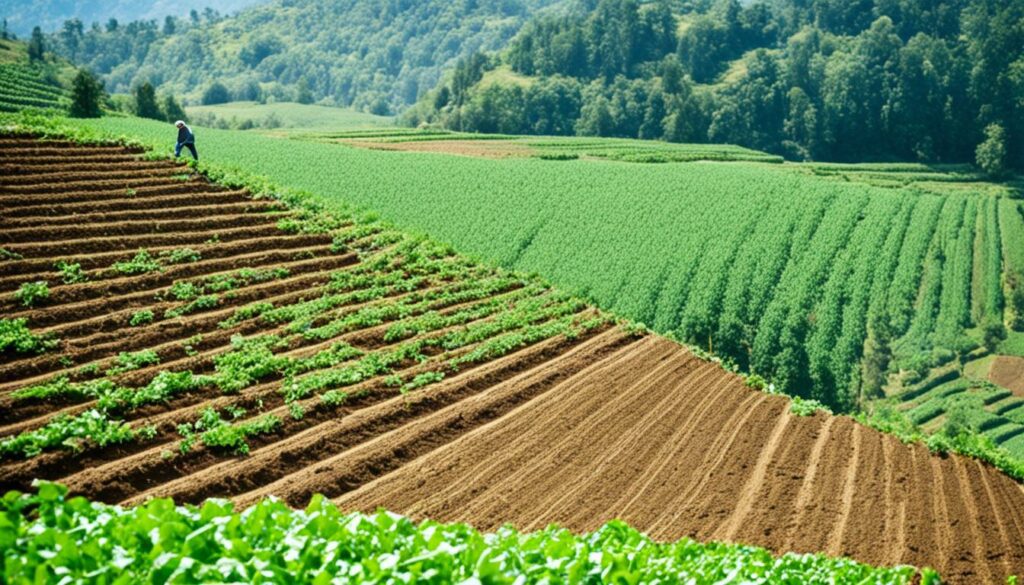
Conservation tillage is a standout method. It means disturbing the soil less. Methods like no-till farming keep plant roots strong and cut down on soil loss. This is vital for stopping soil loss, keeping soil moist, and making the soil healthier.
Contour farming is great for areas that are on a slope. By planting in lines across the hill, we slow down water and stop the soil from being washed away. It helps a lot in areas where soil erosion is a big problem, keeping the earth healthy and holding onto water.
Strip cropping mixes tall and short crops. It’s a good way to fight against wind that can blow the soil away. This method also keeps the soil covered, helping to build up soil health and support more plants and animals.
Windbreaks are rows of trees or bushes. They keep the soil from moving when it’s windy. They also make a place where plants and animals can thrive, helping the whole area stay in good shape.
Crop rotation involves changing the kind of plants we grow on the land each year. This helps keep the soil rich and healthy. It also makes it harder for pests to grow on the crops.
Cover crops are grown to help look after the soil. They stop the soil from drying out, prevent erosion, and support tiny helpful creatures. These plants play a big role in making the soil better.
Buffer strips are lines of trees and bushes by water. They stop dirt and harmful chemicals from getting into the water. It’s an important way to keep water clean.
| Technique | Benefits |
|---|---|
| Conservation Tillage | Minimises erosion, retains moisture, improves soil structure |
| Contour Farming | Prevents runoff, halts erosion, increases water retention |
| Strip Cropping | Combats wind erosion, maintains soil cover, enhances biodiversity |
| Windbreaks | Reduces wind disruption, protects crops, stabilises microclimate |
| Crop Rotation | Enhances soil structure, mitigates pest problems, maintains nutrients |
| Cover Crops | Reduces erosion, retains moisture, promotes soil health |
| Buffer Strips | Controls sediment, prevents water wash-off, stabilises soil |
Using these methods together makes a strong plan for looking after the soil. Each method brings special benefits that add up to better farming and a healthier environment.
Conservation tillage is key for keeping soil healthy and farming sustainable. It focuses on lessening soil disturbance and keeping the soil’s structure intact. A 2010 study showed that 47% of California’s crop production used these methods. These methods are chosen to prevent soil erosion, help keep water in the soil, and encourage more plant and animal life on farms.
Conservation tillage includes methods that disturb the soil as little as possible. These methods keep at least 30% of the soil covered by plant remains. The main aim is to lower soil erosion and improve how much water the soil can hold. Studies show that using less tilling can cut down on field work by over 40%. This saves on fuel and cuts down on costs.
Using conservation tillage brings many good points for both money and the environment. It lessens how tight the soil gets, cuts down on air and water pollution, and makes the soil richer. A group called CASI works to get more farmers in California to use these methods by 2028. They have events like conferences and workshops to teach farmers about using less tillage.
| Technique | Key Benefits |
|---|---|
| No-Till Farming | Reduces soil erosion, retains moisture, enhances soil structure |
| Strip-Till | Improves seed-soil contact, warms soil faster |
| Ridge-Till | Allows earlier planting, reduces residue interference |
| Mulch-Till | Significantly reduces erosion while maintaining soil surface residue |
No-till farming is a main part of conservation tillage techniques. It leaves all crop leftovers on the soil. This keeps the soil from eroding and lets water into the ground better. No-till can also make the soil less compact. This helps plants grow stronger roots and take in water better. Keeping old crops on the soil also stops soil from blowing or washing away. It makes the air cleaner and keeps important nutrients for plants from leaving the soil. So, no-till farming is a very important part of farming in a way that’s not bad for the Earth.
Contour farming is a smart method used in farming today, especially on slopes of two to ten percent. It involves planting crops in lines that follow the natural shape of the land. This method helps reduce soil erosion and saves water effectively.
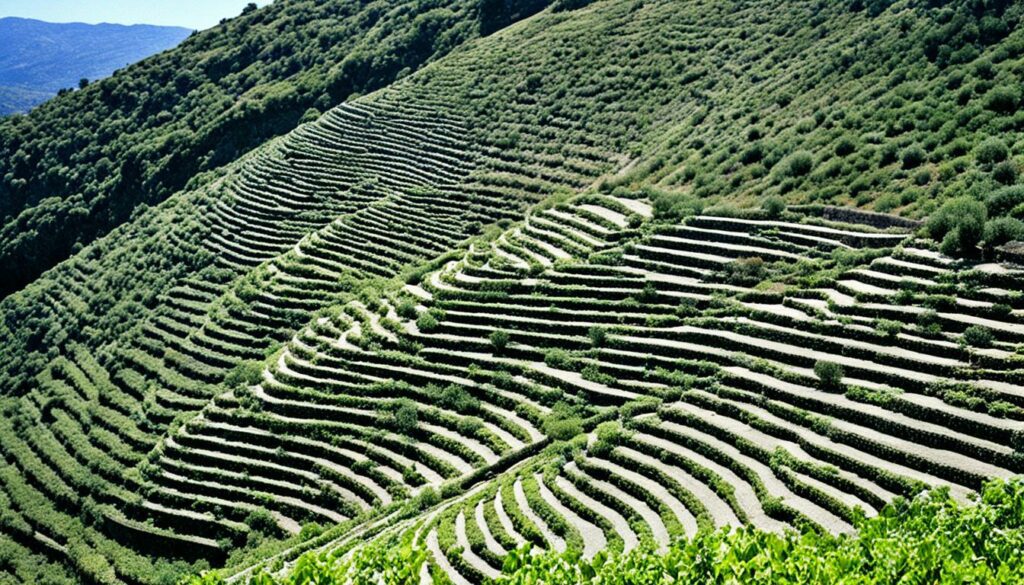
This farming technique plants crops following the natural shape of the land. It creates ridges that slow down the flow of water. This lets the water soak into the ground more, saving it for the plants.
Starting contour farming doesn’t cost much more than other methods. It begins with a land survey that might cost between $5 to $10 for each acre. The success of this method depends on how even the slope is and what farming methods were used before.
Contour farming does more than just control soil erosion. It can cut soil loss by half, especially on slopes between two to eight percent. Plus, it helps keep the soil moist longer by managing rainwater better.
It allows for adding permanent strips of plants to adjust the rows as needed. This is great for top ridges or slopes that are not even. For the best results, nearly all the crop area should be under a slight three percent slope.
But, there might be extra work planting and harvesting because of the way the rows are laid out. The closer the rows are to the true shape of the land, the better they are at controlling soil erosion and saving water.
Strip cropping is key in farming to stop soil from washing away. It boosts profits too. It uses a mix of crops to keep the land healthy. And it helps more plants and animals thrive.
This method plants different crops in lines across fields. It’s great for hills because it stops the soil from moving. Different crops help water soak into the ground better. They also keep the ground damp and make it more fruitful. This lowers the amount of mud and dirt in the air, making the soil healthier.
There are many types of strip cropping for different lands. For example, there’s a way for slopes, flat lands, steep hills, and windy places. Each kind fights soil loss and keeps the ground strong in its own way.
Setting up strip cropping needs thought. Fields are divided into strips of crops, usually 25 to 75 feet wide. This is to stop soil from running off. The right strip size and layout are very important, especially on hills.
Adding green manure and cover crops makes strip cropping even better. These help keep the soil in place and fight weeds. Also, a method called strip-till farming is used. It means little or no digging, which helps on several fronts.
Using at least half erosion-proof plants in the strips is vital. Monitoring tools, like EOSDA Crop Monitoring, help spot issues early. This makes strip cropping work well and saves money.
The financial side of strip cropping is strong too. It saves the soil and water while raising profits. Bringing strip cropping together with other ways to care for the land boosts farming as a whole.
Windbreaks and shelterbelts are key in stopping wind erosion on farms today. They are natural walls made of trees or shrubs set up to slow down the wind. This protects the soil and crops from getting damaged by strong winds.
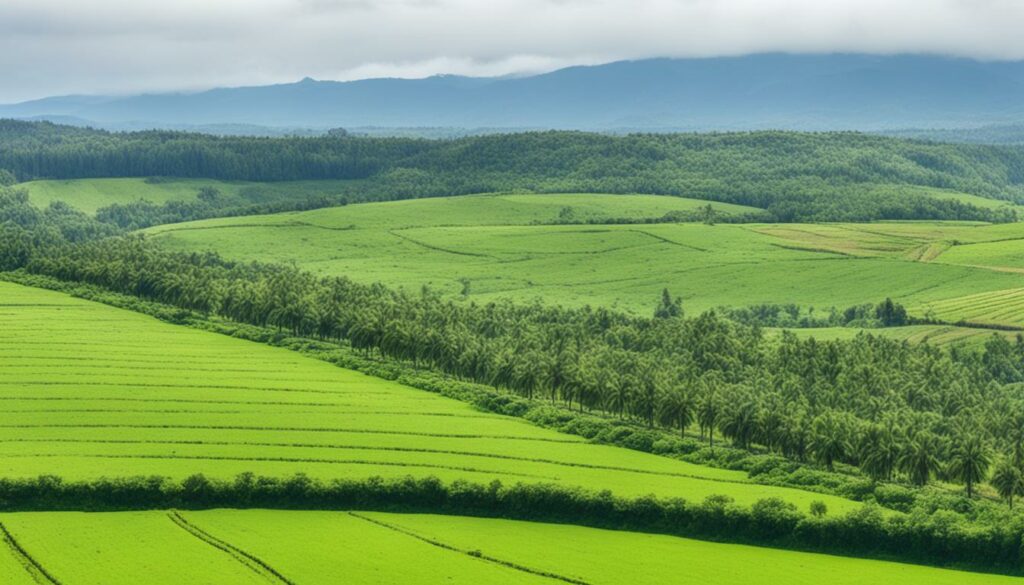
Windbreaks are like walls of trees and shrubs made to block the wind. They’re not just any planting but a careful setup. By being spaced correctly and not too close together, they offer great protection. They help plants grow well by keeping the soil moist and reducing soil being blown away.
Using shelterbelts doesn’t just stop wind erosion. It brings other benefits too:
To keep these systems working well, they need some care from time to time. This includes trimming and possibly replacing some trees or shrubs. It’s important to combine them with other farming practices too. These include how crops are rotated and how leftover plant parts are handled.
Picking the right types of trees and shrubs matters a lot too. Choosing them carefully ensures the windbreaks and shelterbelts help not just the farm but also the local nature.
| Element | Description |
|---|---|
| Shelterbelt Density | 40-60% cover for optimal wind reduction |
| Row Length | At least 10 times the height of windbreak |
| Plant Spacing | 2-4 meters apart, with a 2-meter gap from fences |
| Species Selection | Locally native species preferred for higher survival rates |
By using shelterbelts well, farmers can make their fields more resistant to wind erosion. This helps keep their farm viable and the land balanced. These systems are crucial for the long-term success of farming.
Crop rotation means changing the types of plants grown in one area. It’s an old farming method that has many benefits. It helps farmers keep the soil healthy and boost their crop output.
Changing crops often reduces the number of pests. This means farmers can use fewer chemicals. It also stops diseases that like to target the same crop grown over and over.
Another benefit is adding plants like legumes to the mix. These plants add nitrogen to the soil, making it better for other crops. Adding them can increase corn harvests by as much as 48% after four years of growing different plants.
About 40% of major crops were grown without tilling the soil much in recent years. This shows how new and old farming tips, like using crop covers, are being combined. Even though not many farmers are using crop covers yet, they show great potential for the future.
Crop rotation also helps prevent soil erosion and keeps water in the ground. This is super important in dry areas. It means farms can better survive times when there’s not enough rain.
Using crop rotation can make farms more money. It does this by increasing the amount and quality of crops grown. Plus, it saves money by cutting the effects of soil erosion, which often leads to lower crop yields.
By using crop rotation, farmers can take care of their land better. They use a mix of plants to keep the soil healthy. This, along with keeping pests in check, means better farming for the future.
Cover crops are vital for good soil health. They are key to effective soil management. They increase soil organic matter, which improves the soil’s structure and fertility. Cover crops help reduce soil erosion, which has destroyed about 50 million fertile acres. This makes sustainable farming more important than ever.
In the Cotton Belt, cover crops have shown great results. They increased wheat yields by 35% and corn by up to 75%. This shows the power of green manure in adding important nutrients to the soil. They also lower the need for chemical fertilizers and keep weeds at bay, promoting a diverse crop ecosystem.
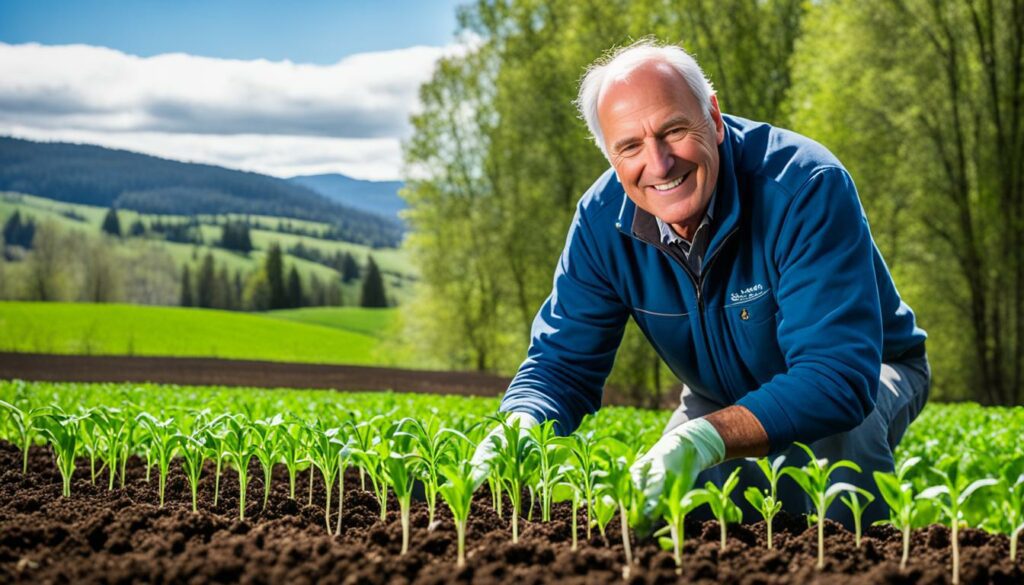
Over 100 million acres have lost their top layer of soil to erosion. Innovative farming solutions are crucial. Cover crops not only boost yields but also add organic matter, help the soil keep moisture, and stabilize its structure. These crops, like field peas and crimson clover in the South, and winter crops such as wheat in the North, effectively reduce erosion and enhance farm yields.
Cover crops bring many benefits. Here’s a look at how different regions benefit from them:
| Region | Cover Crops | Benefits |
|---|---|---|
| Cotton Belt | Cereal Rye, Crimson Clover | 35% increase in wheat yields, 75% increase in corn yields, reduced soil erosion |
| North | Field Peas, Vetch, Wheat | Enhanced nitrogen fixation, improved soil organic matter, weed suppression |
| South | Field Peas, Vetch, Crimson Clover, Rye | Improved soil moisture retention, biodiversity in crop systems |
Despite their clear benefits, cover crops are still underused. To combat erosion and promote sustainable farming, their use must increase. This is especially key on sloped areas, where most crops grow. Using more cover crops can lead to a stronger and more sustainable farming system.
Buffer strips are often made up of trees or thick plants. They are really important for keeping water bodies clean. They help by stopping nutrients and sediment from getting washed into water.
Also, they make both farms and the wild better and healthier. This is because they stop harmful things from entering the water.
Buffer strips are vital for keeping water clean and managing farm runoff. They catch pollutants like sediment and chemicals. This makes the water better for everything living in it.
Good buffer strips can stop a lot of sediment. They also reduce the amount of soil that washes away. And, they make sure water near farms stays clean.
Setting up buffer strips well is important. First, you must make sure most of the ground is covered. This helps stop soil from washing away.
The strip should be wide, especially if it’s mainly made of grass and other plants. Using the right mix of plants is key. They need to be thick to work well.
Don’t drive heavy machines on buffer strips. This damages the soil and plants. While cutting the plants can help, too much cutting is bad. Some grasses grow thicker from the bottom up, which helps trap pollution better.
Using less aggressive farming near buffer strips is smart. It protects the soil and plants. This can decrease soil loss a lot, making the land healthier overall.
Buffer strips also help farm profits and the environment. They make good homes for wildlife. They can also stop some harmful gases and offer extra income from farming. Designing them carefully is crucial for them to work well and last long.
Conservation agriculture focuses on keeping fields healthy. It uses methods like less soil disturbance, managing crop leftovers, and smart crop changes. This helps the soil stay healthy and grow better crops. Let’s see how these methods work.
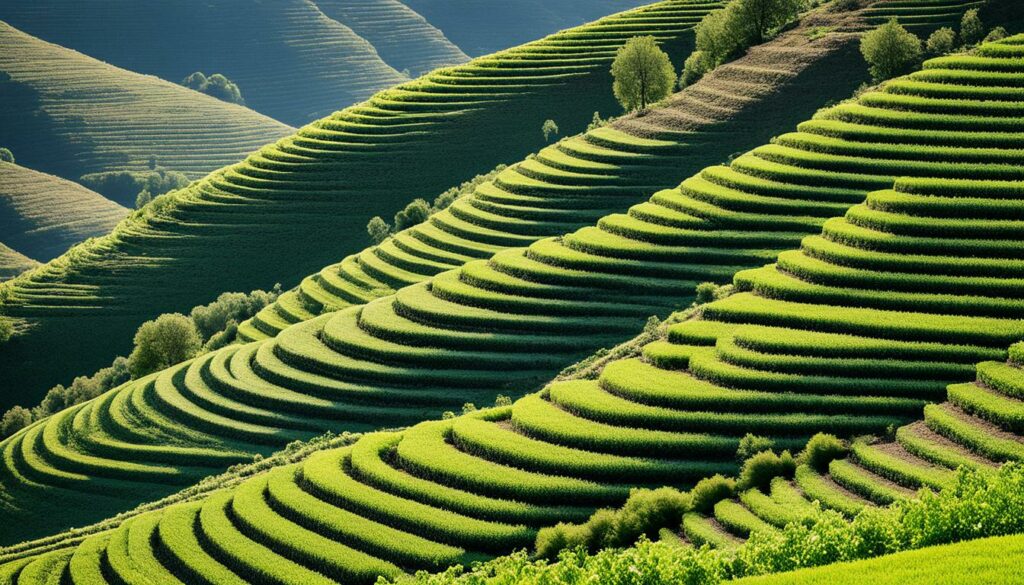
To do conservation agriculture, farmers avoid disturbing the soil too much. They keep the soil covered all the time and change the crops they grow. Practices like conservation tillage or no-till are used to keep the soil in good shape. Cover crops and mulches also help. They protect the soil, stop erosion, and keep moisture in.
Choosing conservation agriculture has many benefits. It means more organic matter in the soil, less erosion, and better fields for the future. It also helps farms deal with climate change and avoid the bad effects of old farming ways. By using these methods, farms stay productive and sustainable for a long time.
It’s vital to conserve soil moisture well for better farming. Conservation tillage stops a lot of soil from drying out and evaporating. This keeps more water in the soil for crops to use.
Also, this method helps keep the soil undisturbed. So, it holds its shape and lets water get in easily. By not digging up the soil, more natural things stay in it. This helps keep water in the soil. As a result, we don’t need to water the plants as often.
Adding mulch on top of the soil also helps a great deal. It stops the sun from drying up the soil fast. This way, the soil stays moist and perfect for plants. For hilly areas, planting along the hills’ curves saves more rain. This stops soil from washing away and stores more water for the earth.
Using cover crops is another smart move. It adds good things to the soil, like leaves and stems. What’s more, these crops make spaces for tiny creatures that help the soil. They stop water from running off and make the soil keep water better. Cover crops and conservation tillage are a great pair. They do wonders for the soil together.
For those keen on the how-to, here’s a look at several ways to save soil moisture. It talks about what each way helps with and what could make it hard to use:
| Technique | Benefits | Barriers |
|---|---|---|
| Conservation Tillage | Reduces soil erosion, improves infiltration rate, manages organic levels | Requires initial investment in equipment |
| Mulching | Retains soil moisture, reduces evaporation, enhances soil fertility | Labour-intensive application |
| Contour Farming | Prevents erosion, optimises rainwater use, reduces runoff | Less effective on flat terrain |
| Cover Cropping | Provides organic matter, enhances soil structure, controls weeds | Competition for water with main crops |
Using these ways can really make the soil better. They help save water and make farming last longer. By doing a mix of these, farmers can stay strong against changing weather. They keep the land healthy for many years.
Effective soil conservation is key for farming to last long. By putting back organic matter, farmers keep 90 to 95 percent of soil’s productivity. This is critical for keeping the land fertile.
No-till farming, for example, keeps 60 to 70 percent of crop residue. It helps control erosion, saving soil quality and boosting crop output.
Soil erosion costs a lot, with over $90 million lost each year from lower crop yields and lacking nutrients. Citizens also pay about $9.1 million every year because of these problems. But, conserving soil doesn’t just save money. It stops erosion, keeps the land productive, and avoids needing new farming areas.
Practices like no-till and conservation tillage lessen soil disturbance. They help keep soil structure and water in the ground. These methods also make the air and water cleaner by reducing pollutants.
Adding to that, crop rotation and planting cover crops and buffer strips make the soil healthier. They control pests and protect water, making farming more sustainable and tough. It’s important to use these soil conservation ways for the future. This will help secure our farming for people in the coming years.
Soil conservation is about saving soil from getting worse. This includes stopping erosion, making sure soil stays fertile, and avoiding chemicals that harm it. The goal is to keep the land healthy for growing plants and feeding animals.
Keeping the soil safe is key to feeding people and animals. It stops the ground from washing away, keeps it full of nutrients, and helps farmers grow food. This is also good for the environment and saves wildlife’s homes.
Soil erosion comes from things like farming, cutting down too many trees, and letting animals eat too much grass. These actions can make the soil less strong and cause the best part of it to blow or wash away.
To prevent soil erosion, you can try certain farming methods. These include planting in lines, not digging up the soil too much, changing what you plant, and adding trees. It’s also important to keep an eye on these methods to make sure they’re doing their job.
Looking after the land well helps soil, water, and air quality. It also boosts how many crops can grow and supports many kinds of plants and animals. This way of farming helps the land stay healthy for a long time.
Conservation tillage means farming in a way that’s gentle on the soil. This keeps the ground mostly covered and not churned up too much. It helps the soil hold onto water, stops it from washing away, and supports many living creatures.
Contour farming is about planting crops following the land’s natural curves. This stops the soil from being washed away and helps water spread out slowly. It means the crops get enough water, and the soil stays in place.
Strip cropping is planting different crops beside each other across a field. This helps stop soil from blowing away and attracts more plants and animals. It also makes the soil richer, which means better crops can grow.
Windbreaks and shelterbelts are rows of trees or bushes that slow down the wind. They protect crops and soil from getting damaged. They also give a home to animals and make the land more fertile.
Rotating crops makes the soil stronger and better at holding water. It keeps the soil full of the right nutrients and stops pests from getting too used to living there. Adding certain plants helps even more by putting good things back into the soil.
Cover crops are planted in between main crops to protect the soil. They stop weeds, keep moisture in, and add good stuff to the earth. Some also grab nitrogen from the air, which means not needing as much harmful fertiliser.
Buffer strips, made of trees or thick plants, keep water safe from what runs off the land. They stop the water from being dirty and losing the important stuff for plants and animals. This helps keep rivers and lakes clean and full of life.
Conservation farming is about using the best ways to look after the soil and what grows on it. It means not churning the soil too much, always keeping it covered, and planting different things at different times. These simple steps make the land stronger and keep it good for farming.
To keep moisture in the soil, try farming methods that don’t disturb it too much. Add things on top, like mulch or cover crops. These ideas help water soak in and not disappear into the air. The result is more water for the plants to use.